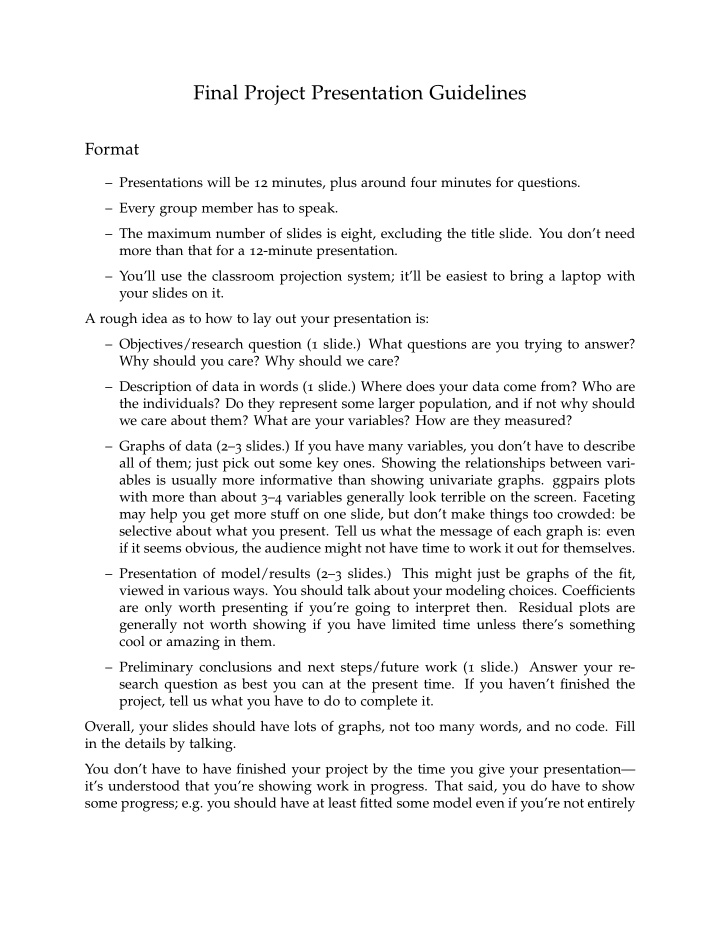



Final Project Presentation Guidelines Format – Presentations will be 12 minutes, plus around four minutes for questions. – Every group member has to speak. – The maximum number of slides is eight, excluding the title slide. You don’t need more than that for a 12 -minute presentation. – You’ll use the classroom projection system; it’ll be easiest to bring a laptop with your slides on it. A rough idea as to how to lay out your presentation is: – Objectives/research question ( 1 slide.) What questions are you trying to answer? Why should you care? Why should we care? – Description of data in words ( 1 slide.) Where does your data come from? Who are the individuals? Do they represent some larger population, and if not why should we care about them? What are your variables? How are they measured? – Graphs of data ( 2 – 3 slides.) If you have many variables, you don’t have to describe all of them; just pick out some key ones. Showing the relationships between vari- ables is usually more informative than showing univariate graphs. ggpairs plots with more than about 3 – 4 variables generally look terrible on the screen. Faceting may help you get more stuff on one slide, but don’t make things too crowded: be selective about what you present. Tell us what the message of each graph is: even if it seems obvious, the audience might not have time to work it out for themselves. – Presentation of model/results ( 2 – 3 slides.) This might just be graphs of the fit, viewed in various ways. You should talk about your modeling choices. Coefficients are only worth presenting if you’re going to interpret then. Residual plots are generally not worth showing if you have limited time unless there’s something cool or amazing in them. – Preliminary conclusions and next steps/future work ( 1 slide.) Answer your re- search question as best you can at the present time. If you haven’t finished the project, tell us what you have to do to complete it. Overall, your slides should have lots of graphs, not too many words, and no code. Fill in the details by talking. You don’t have to have finished your project by the time you give your presentation— it’s understood that you’re showing work in progress. That said, you do have to show some progress; e.g. you should have at least fitted some model even if you’re not entirely
happy with it. The standard for “some progress” will be higher for groups presenting late than for groups presenting early. Grading Your presentation will be worth a quarter of your final project grade ( 10 % of your overall grade.) You’ll be graded on the following criteria (not all of equal value): – Statement of goals. What questions are you trying to answer? Why do you care? Why should we care? – Description of your data. This should include both a graphical display and a verbal description of what your variables are, who the individuals in your data from, and how they were selected/sampled. If you have many variables, you don’t have to describe all of them, just pick out some key ones. – Demonstration of progress toward those goals. This will almost certainly involve fitting a statistical model (or models) of some kind, and showing that these models tell you something of interest. Note that the minimal amount of progress groups need to show will increase as time goes on. (You don’t need to show everything though; pick out a couple of important or interesting results.) – Identification of work left to do/limitations. It’s EDA, so we expect good, thoughtful work, not perfect work. However, you should have a clear idea of what the imper- fections in your work are (what doesn’t fit well? what other variables would you really want to know?), and how they could potentially be addressed. – Presentation: You’ll also be graded on professionalism. Your graphs should be well-labeled and readable, and it’s your responsibility to get across to the audience what your research question is and how you’re trying to solve it. The presentation doesn’t have to be perfect, but it should be clear that you’ve done a decent amount of preparation. Schedule Thursday 11 / 29 : – Joe, David, Yaying – Joe and Conor – Guangyong and Han
– Jackson – Adam Tuesday 12 / 4 : – Hector – Hanqing, Wenhao, Dandong – Mohan and Seiji – Gayatree and Jatin Thursday 12 / 6 : – Jooyong, Sizhe, Alex – Zehong, Chen, Qianwen – Dakota and Tony – Esme
Recommend
More recommend